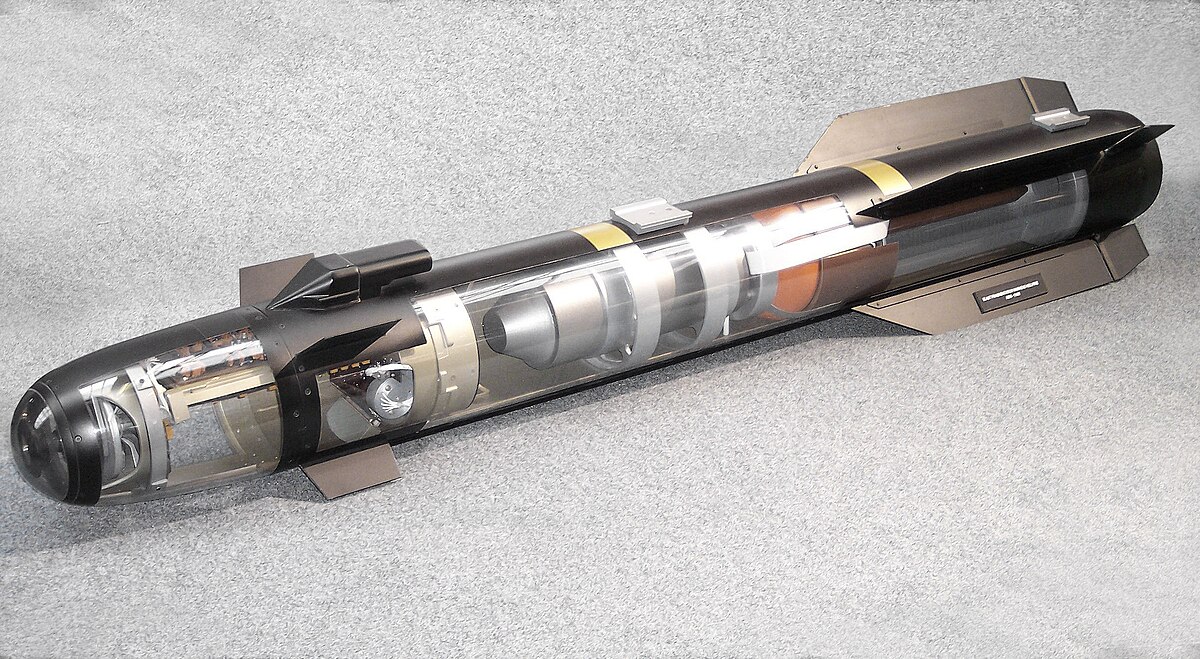Errreembuhr
CEO of EODD

OUT OF CHARACTER INFORMATION
- Intent: To provide a high-powered air-to-ground anti-vehicle missile
- Image Source: Hellfire Missile
- Canon Link: N/A
- Restricted Missions: N/A
- Primary Source: Concussion Missile, Thermal Detonator, Baradium
PRODUCTION INFORMATION
- Manufacturer: EODD
- Model: EGM-7 Heavy Air To Ground Missile
- Affiliation: Closed-Market
- Modularity: N/A
- Production: Minor
- Material: Plasteel casing, Turadium penetrator, Baradium charge, Targeting and flight electronics, Ion drive
TECHNICAL SPECIFICATIONS
- Classification: Air-to-Ground Missile
- Size: Large
- Weight: Heavy
- Ammunition Type: Missile
- Ammunition Capacity: 1
- Reload Speed: N/A (cannot be replaced in combat)
- Effective Range: Battlefield
- Rate of Fire: Very Low (single-shot)
- Stopping Power: Very High
- Recoil: N/A
SPECIAL FEATURES
- Turadium Penetrator
- High-Explosive Baradium Charge
Strengths:
- Anti-Armor Combination: The EGM-7’s primary assault method is a one-two punch of a turadium penetrator cap and a thermite-ignited baradium charge. The penetrator acts to punch through enemy vehicle armor, using a rapidly-burned secondary solid fuel stick to boost it to maximum speed at approximately 30m from its target. Once the penetrator has bypassed enemy armor the thermite charge is set off via a pressure plate triggered by the impact, igniting the baradium charge, which is 3 times the size of the baradium present in a standard thermal detonator for exceptional damage.
- Fire and Forget: The missile itself carries a rudimentary targeting computer, allowing for data transmitted from the operator’s targeting system to guide it to its target and reliably deliver its payload without further input from the operator.
- Controlled Damage: Collateral damage was a concern when developing the EGM-7, and the pre-explosive penetration warhead helps to limit this. WIth proper function the warhead will not detonate until after it has entered the enemy craft, controlling the explosion to the interior of whatever vehicle it enters. At worst the internal pressure from the explosion may send pieces of the craft flying as shrapnel, but sufficiently strong buildings likely won’t suffer much damage from this.
- Vehicle-Lock Only: The EGM-7 can only be fired when the targeting system has achieved lock on an enemy vehicle. It cannot be fired on infantry because of this.
- Anti-Missile Fire: The missile travels quickly across distance to its target, but when it reaches a distance of 300m from its target, it locks into a straight-line trajectory. This gives enemy ground defenses or fighters ample opportunity to shoot it out of the sky before it can reach its target. Physical projectiles such as mass drivers/slugthrowers are especially effective against the weapon’s body.
- Jamming: The EGM-7 contains no on-board anti-jamming systems, leaving it vulnerable to anti-missile electronic warfare. If the targeting system can be knocked out in such a way the missile is likely to miss its target, though the explosive warhead will still detonate on impact with the ground.
- Limited Ammunition: By its very nature a missile is a one-time use, and the EGM-7 is no different in this regard. Despite its power any vehicle carrying them is limited in how many it can carry by its size, and once they’re gone, they can only be replaced outside of combat.
DESCRIPTION
While a mass-driver is already in their arsenal to take out ground vehicles, EODD’s R&D department decided that a powerful air-to-ground missile was the next step up. The EGM-7 fills this role as an exceptionally powerful AGM. Whether fired from gunships or atmospheric superiority fighters, it’s designed to provide a massive threat to enemy armor on the ground.
The missile’s construction aids in this. The very front of the missile contains a targeting computer and range-finder which guides the ordnance from its launch position to the target based on information transmitted from the launch operator. An ion drive and stabilizing fins move the unit from launch through the air to its target using this information, and when the unit comes within 300m of its target, the computer and drive work in tandem to put it on a flat line trajectory.
Once the trajectory is secured these targeting systems are discarded from the missile, revealing the turadium shaped penetrator beneath, which is equipped with a pressure trigger for the explosives behind it. The ion engine at this point accelerates to speed capable of punching the penetrator through even exceptionally dense armor, though given its flat and predictable trajectory, this is when the missile is most vulnerable to being shot out of the sky. Should it survive incoming fire or jamming attempts, and penetrate vehicle armor, the pressure trigger will activate, with a half-second delay before a small thermite charge is detonated. While insignificant on its own, this charge itself acts as a trigger for a much larger baradium charge.
While nowhere near as powerful as Baradium Missile used in the years after the Galactic Civil War some centuries ago, the missile contains enough baradium to produce an explosion with a ten meter blast radius, incinerating anything within its range. Of course while the hull of a tank or a walker would survive the blast, anything inside wouldn’t be near as lucky, especially not organic beings, droids, or electronics and vehicle operating systems. With the explosion contained inside the hull, collateral damage is limited, though with weak enough armor the pressure may cause bursting, sending shrapnel flying. In a combat situation, used against a vehicle surrounded by enemy troops, this can be a great boon with a lucky hit.







